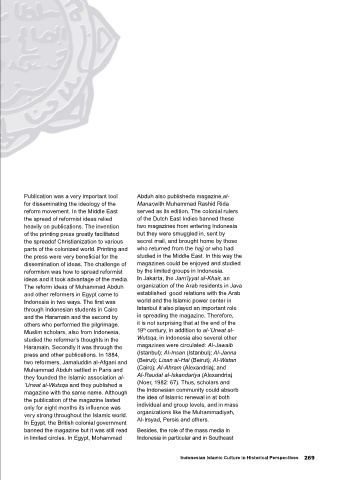Page 279 - INDONESIAN ISLAMIC CULTURE IN HISTORICAL PERSPECTIVES
P. 279
to emerge. Within the Sarekat The most significant challenge to Publication was a very important tool Abduh also publisheda magazine,al-
Islam, where people from all Islamic reform is modernism itself. The basic for disseminating the ideology of the Manar,with Muhammad Rashid Rida
orientations gathered, communism was considerations of modernism had to be reform movement. In the Middle East served as its edition. The colonial rulers
also present and could grow along with accepted, where as modern institutions the spread of reformist ideas relied of the Dutch East Indies banned these
the other members. It was not surprising in Islamic circles had to be created. heavily on publications. The invention two magazines from entering Indonesia
that there even were communist The pesantren educational system of the printing press greatly facilitated but they were smuggled in, sent by
pilgrims, like Haji Misbah in Solo. In that was devoid of any systematic the spreadof Christianization to various secret mail, and brought home by those
Semarang, a communist-oriented group method of learning, had no curriculum, parts of the colonized world. Printing and who returned from the hajj or who had
founded the Sarekat Rakyat, which later no class, and no criticism was clearly the press were very beneficial for the studied in the Middle East. In this way the
became the Communist Party. This may incompatible with the modern mind-set. dissemination of ideas. The challenge of magazines could be enjoyed and studied
have come about under the influence of A European style school system needed reformism was how to spread reformist by the limited groups in Indonesia.
Sneevliet who had brought communism to be adopted and adapted as it suited ideas and it took advantage of the media. In Jakarta, the Jam’iyyat al-Khair, an
from the Netherlands and established the modern mind-set much better. So a The reform ideas of Muhammad Abduh organization of the Arab residents in Java
the Indische Sociaal Democratische European school was founded, but the and other reformers in Egypt came to established good relations with the Arab
Vereeniging (ISDV). Islamic faith was an integral part of it Indonesia in two ways. The first was world and the Islamic power center in
Entering the first quarter of the because renewed faith was the soul of through Indonesian students in Cairo Istanbul it also played an important role
20 century, nationalism began to reform. The Adabiyah school in Padang and the Haramain and the second by in spreading the magazine. Therefore,
th
emerge and it led to Muslims to was actually a HIS met de Kor’an. The others who performed the pilgrimage. it is not surprising that at the end of the
th
become divided into two groups: School taught general subjects like any Muslim scholars, also from Indonesia, 19 century, in addition to al-’Urwat al-
nationalists and Islamists. In 1924, regularly HIS school, but added teaching studied the reformer’s thoughts in the Wutsqa, in Indonesia also several other
1930, and 1939-40, there were at least of Islam. Later, the Muhammadiyah Haramain. Secondly it was through the magazines were circulated: Al-Jawaib
three debates between nationalists built HIS met de Kor’an in various press and other publications. In 1884, (Istanbul); Al-Insan (Istanbul); Al-Janna
and Islamists. The nationalists were other places and it also established two reformers, Jamaluddin al-Afgani and (Beirut); Lisan al-Hal (Beirut); Al-Watan
represented by Soekarno, where as Islamic based schools for teachers, the Muhammad Abduh settled in Paris and (Cairo); Al-Ahram (Alexandria); and
the Islamists were represented by Kweekschool. As a reform organization, they founded the Islamic association al- Al-Raudat al-Iskandariya (Alexandria)
three Muslim reformist leaders, namely the Muhammadiyah not only worked ’Urwat al-Wutsqa and they published a (Noer, 1982: 67). Thus, scholars and
Agus Salim, A. Hasan and Mohammad to broadcast religious propaganda to magazine with the same name. Although the Indonesian community could absorb
Natsir. This shows that while in the spread the teachings of modernist Islam, the publication of the magazine lasted the idea of Islamic renewal in at both
Islamic world of the MiddleEastthe but also established modern institutions, only for eight months its influence was individual and group levels, and in mass
idea of Pan-Islamism spread, Islam such as public schools, hospitals, very strong throughout the Islamic world. organizations like the Muhammadiyah,
in Indonesia was just the opposite. It scouting organizations and home care. In Egypt, the British colonial government Al-Irsyad, Persis and others.
was not attracted to the idea of Pan- The organization also published of banned the magazine but it was still read Besides, the role of the mass media in
Islamism, but rather to nationalism. journals and magazines. in limited circles. In Egypt, Mohammad Indonesia in particular and in Southeast
268 Indonesian Islamic Culture in Historical Perspectives Indonesian Islamic Culture in Historical Perspectives 269

